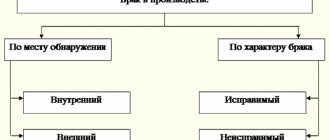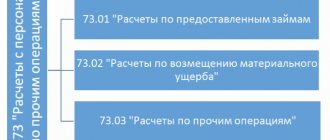Any entrepreneur or head of an organization strives to ensure that his products are of appropriate quality. But it is impossible to completely insure against defects, and at any stage of production, there are many reasons for this. Monetary losses incurred as a result of the release of defective products must be accounted for. Let's look at how to correctly enter in accounting the amounts associated with the results of defects in production.
Question: The purchasing organization using the simplified tax system, when transferring previously purchased raw materials from the warehouse to the main production, discovered a defect, returned the defective raw materials to the supplier, and the supplier returned the money paid to him. How to reflect these transactions in the organization's accounting? The cost of raw materials amounted to 60,000 rubles, including VAT of 10,000 rubles. View answer
Manufacturing defect: a good thing won’t be called that
In the field of production, a defect is a product or its element (it can be a semi-finished product, part, assembly), the quality of which does not fit into the norms, standards, technical conditions adopted at the enterprise, and which is impossible to use for its intended purpose or is only permissible with additional adjustments that require costs. .
FOR YOUR INFORMATION! The definition of manufacturing defects, used in modern legal acts, repeats clause 38 of the Basic Provisions for Planning, Accounting and Calculation of Costs at Industrial Enterprises, approved by the State Planning Committee of the USSR, the State Committee for Prices of the USSR, the Ministry of Finance of the USSR and the Central Statistical Office of the USSR on July 20, 1970.
What is included in financial losses as a result of marriage:
- irreparable costs for the cost of a defective product (money for raw materials, salaries to employees, payment of energy for equipment operation, etc.);
- expenses for corrective actions to bring the product to acceptable quality (this includes remuneration for workers’ labor and funds for equipment maintenance);
- funds for identifying and formulating defects (for example, creating a list of typos);
- reimbursement to the consumer of low-quality products for the expenses incurred by him (these include the cost of replacing or correcting a product whose quality did not suit the consumer, including transportation costs for its delivery).
What is the procedure for deducting from an employee’s salary for a marriage that arose through his fault?
The following are not considered a manufacturing defect:
- products for which at a particular enterprise there are special requirements that differ from the standard ones for similar products, although the quality meets the standard requirements, but does not fit into the increased ones;
- losses associated with downward transition to another type of product.
The acceptable percentage of defects is the minimum acceptable level of non-compliance with quality. Depends on the nature of production and established quality criteria. At developed enterprises it should not exceed 2-3%, up to a maximum of 5%. Excess is a reason to worry about finding the causes and influencing the detected problems.
the write-off of defective goods in accounting ?
Employee remuneration
The employee who manufactured defective products is paid as follows. If the manufactured product is a complete (irreparable) defect, then in this case the employee’s work is not paid. If a partial (correctable) defect is identified due to the fault of the employee, then it is paid at reduced rates depending on the degree of suitability of the manufactured products. Such rules are established by parts 2 and 3 of Article 156 of the Labor Code of the Russian Federation.
Situation: in what documents are losses from marriage recorded?
In documents approved by the head of the organization.
Any fact of economic life, including the release of marriage, must be confirmed by a primary document (Part 1 of Article 9 of the Law of December 6, 2011 No. 402-FZ).
The forms of primary accounting documents are approved by the head of the organization (Part 4 of Article 9 of the Law of December 6, 2011 No. 402-FZ). For example, if a defect is detected in production, a report can be issued. In this case, the document must contain the mandatory details provided for in Part 2 of Article 9 of the Law of December 6, 2011 No. 402-FZ. In addition, the act should indicate the reasons for the defect, the quantity of defective products, the culprit of the defect, the costs of eliminating the defect and (or) the cost of the defective product, the amounts to be recovered from the culprits of the defect.
Make deductions from your salary to reimburse expenses related to the release of marriage in the same way as deductions related to compensation for material damage.
Characteristics of defective products
According to the time of determination, marriage is divided into:
- internal - the product is recognized as non-compliant with standards at production, before being sent for sale or to the consumer;
- external - discovered by the consumer himself during operation or in the process of preparing for work.
If the manufacturer discovers a defect during the production process, depending on the nature of the quality discrepancies found, the following forms of defect can be distinguished:
- correctable - subject to adjustment, appropriate from the point of view of the invested funds;
- incorrigible – unsuitable for further use, a product that is irrevocably damaged.
IMPORTANT! The combination of these characteristics forms the final cost of defects made in production.
Financial losses from different types of marriage
- Internal incorrigible:
- the cost of wasted raw materials;
- labor remuneration of employees (including social charges);
- means for equipment maintenance;
- shop expenses.
- Internal fixable:
- the above expenses (direct expense items);
- direct costs for correcting defective products and bringing them up to standard.
- External incorrigible:
- cost of goods rejected by the buyer;
- reimbursement to the consumer of the amount he paid for the defective product;
- expenses for dismantling assembled products with detected defects;
- transportation costs associated with replacing the product or delivering it for repairs;
- selling expenses since the goods have already been sold.
- External fixable:
- all of the above financial losses from external defects (except for the costs of replacing goods);
- expenses for repairing defective goods from the consumer (raw materials, supplies, equipment, employee benefits, etc.).
NOTE! From the final amount of losses, you need to subtract funds that can be returned: the ability to reuse unusable products or their elements, funds collected from suppliers for substandard raw materials, monetary sanctions in the event of agreed liability for defective products.
simplified tax system
Regardless of what object of taxation the organization uses when calculating the single tax under simplification, the cost of defects paid by the employee increases the tax base (Clause 1 of Article 346.15 of the Tax Code of the Russian Federation). Take into account the amount of non-operating income at the time of deduction from wages, when depositing money into the cash register, etc. (Clause 1 of Article 346.17 of the Tax Code of the Russian Federation).
If an organization calculates a single tax on the difference between income and expenses, then take into account losses from the production of defective products in this order.
If there was an irreparable defect, then do not include the amounts of expenses associated with the production of defective products in the tax base. These costs are not in the list of expenses that can be taken into account when calculating the single tax (Clause 1, Article 346.16 of the Tax Code of the Russian Federation).
If there was a correctable defect, then the amount of expenses associated with its correction is included in the tax base for the corresponding cost items. For example, write off the cost of additional material resources spent on correcting a defect as material expenses (subclause 5, clause 1, article 346.16 of the Tax Code of the Russian Federation). And the salary of an employee involved in eliminating the defect (if the defect is corrected by another employee) is in the amount of labor costs (subclause 6, clause 1, article 346.16 of the Tax Code of the Russian Federation).
UTII
The object of UTII taxation is imputed income (clause 1 of Article 346.29 of the Tax Code of the Russian Federation). Therefore, the amount of compensation an employee receives for losses from marriage does not affect the calculation of the single tax.
Why marriage can occur
The reasons for the deviation of manufactured products from the relevant quality standards are different and relate to both objective and purely “human” ones.
- Material problems. Low-quality raw materials will not be able to produce excellent products at the output. It is necessary to control suppliers of raw materials and check each batch before starting the production cycle.
- Imperfection or breakdown of equipment. Any mechanisms tend to break down, become obsolete, wear out, and an accident may occur. To minimize defects, you need to take care of the serviceability of equipment, timely maintenance and moral compliance with the technological process.
- Production methods. Incorrectly chosen production technologies can aggravate defects (outdated, or incorrectly applied, or simply unsuccessful). The technologist solves this problem.
- Disadvantages of working conditions. Factors that can provoke marriage include:
- poor lighting of workplaces;
- non-compliance with temperature conditions;
- violation of humidity levels;
- insufficient opportunities to ensure cleanliness of hands, tools, workspace, etc.
- Human factor. Personnel directly involved in the manufacture of products are largely responsible for their quality. The causes of the problems may be:
- insufficient competence of workers;
- low level of practical skills;
- irresponsible attitude;
- low motivation of employees (undeveloped system of rewards for quality and sanctions for defects).
- Objective circumstances. It is possible, for example, a power outage, a failure in the supply of other important resources, or some other force majeure.
- Insufficiently effective quality control system. A defect that occurs for one of the above reasons should not be allowed to reach the consumer, otherwise it will turn from an internal problem into an external problem.
How to document a manufacturing defect
A detected defect, both final and subject to correction, must be documented by a special act. It is compiled by a commission that carries out quality control. The form of the act is developed by the organization independently; there are no strict requirements in this regard, except for the mandatory presence of basic office details. In addition to them, in such an act they usually cite:
- the name of the products that turned out to be defective;
- description of the identified defect, determination of the type (possibility of adjustment);
- assumption or statement of reasons;
- the place where the defect was discovered;
- quantity that does not correspond to quality (in the agreed units of measurement);
- cost of losses;
- identification of the person responsible for the marriage;
- conclusion regarding write-off or correction.
IMPORTANT! If an employee is found to be guilty of a detected defect, as reflected in the report, he must be familiarized with the report and signed.
The act serves as the basis for calculating the final amount of the marriage (calculation), which includes:
- amounts to be recovered from the perpetrators;
- irreparable financial losses;
- material claims against suppliers.
The person bearing financial responsibility delivers the registered defective products to the warehouse upon request-invoice. Subsequently, another act is formulated - for destruction (write-off) or correction of the detected defect.
Accounting for marriage
To justify financial losses as a result of defects, accounting provides for account 28 “Defects in production”:
- the debit reflects expenses for detected internal and external defects;
- The loan takes into account amounts to reduce losses resulting from defects.
It is customary to write off production losses from defects at the end of the month based on the costs of this type of production. For each type of defect, the wiring will have a different appearance.
Postings for accounting for correctable defects
All sorts of entries are given, depending on the specific situation of the defect (the presence or absence of a culprit, the possibility of involving contractors to correct it, etc.):
- debit 28, credit 10 “Fixed assets” - accounting for material expenses for adjusting defects;
- debit 28, credit 70 “Settlements with personnel” - reflection of employees’ salaries when correcting defects;
- debit 28, credit 69 “Calculations for social insurance and security” - calculation of insurance contributions from this salary;
- debit 28, credit 21 “Semi-finished products of own production” - accounting for materials needed for adjustment;
- debit 28, credit 60 “Settlements with suppliers and contractors” - the cost of services of third-party organizations brought in for correction;
- debit 73 “Settlements with personnel for other transactions”, credit 28 – reflection of the amount of material compensation for defects from the guilty employee;
- debit 70, credit 73 – withholding the amount of compensation from the salary of the perpetrator;
- debit 50 “Cashier”, credit 73 – the guilty employee independently deposits the amount of compensation into the cash register;
- debit 20 “Main production”, credit 28 – writing off losses to the cost of products.
Writing off an irreparable marriage
Using the calculation method, the cost to be written off is determined and written off by posting: debit 28, credit 20 “Main production”.
Collections from the perpetrator are accounted for in debit 73 “Settlements with personnel for other operations.” The cost of waste suitable for further use is recorded in debit 10 “Fixed assets”.
Accounting for costs of external defects
There is a difficulty here related to the time of detection: it may well happen that the reporting month ends before the consumer reports the detected defect. The following nuances must also be taken into account:
- accounting for external defects is carried out not at cost, but at the full cost of the products (after all, they were sold);
- expenses of this kind are written off against a specially created reserve for repairs and maintenance, including under warranty (account 96 “Reserves for future expenses”).
- if the defect was returned in the reporting period, the losses are written off to cost (debit 90 “Sales”, credit 28).
What to do if a manufacturing defect is identified?
At one of the stages: during the production process, storage of finished products in a warehouse, or after selling the goods to the final buyer, a defect is identified.
Responsible employees determine what type of “rejected products” are: (click to expand)
- correctable defects (products are subject to modification, after which they acquire all the required technical characteristics. It is important that the costs of modification are economically justified);
- irreparable defect (rework of rejected products is impossible, or the costs of rework are too high and not economically justified).
If a decision is made to eliminate product defects and the defect is considered correctable, then the product is sent to the workshop for revision. To the cost of repairable defects, the costs of materials, employee wages with deductions, etc. are added. Subsequently, the product is returned for sale.
If the defect cannot be corrected, the responsible employee determines what in the product can be usefully used in production, and what should be recycled? If the components retain their usefulness (for example, zippers in a tailoring workshop), they will be separated from the rejected product and used for their intended purpose in the production of similar products. The cost of useful scrap parts is determined by the price of possible use.
If an enterprise produces warranty products, then it is obliged to create a reserve for repairs. In this case, losses from defects are written off against the guarantee reserve (account 96).
When identifying rejected products, the person who caused the defect is always identified. The culprit may be a supplier of low-quality materials or an employee of the enterprise. A claim is submitted to the supplier. If it is recognized by the supplier, the amount of compensation paid by him is counted towards the reduction of defective expenses.
If an employee is found to be at fault, then the amount of expenses related to the marriage is established and is subject to deduction from wages. By law, you can deduct no more than 20% from your salary each month.







